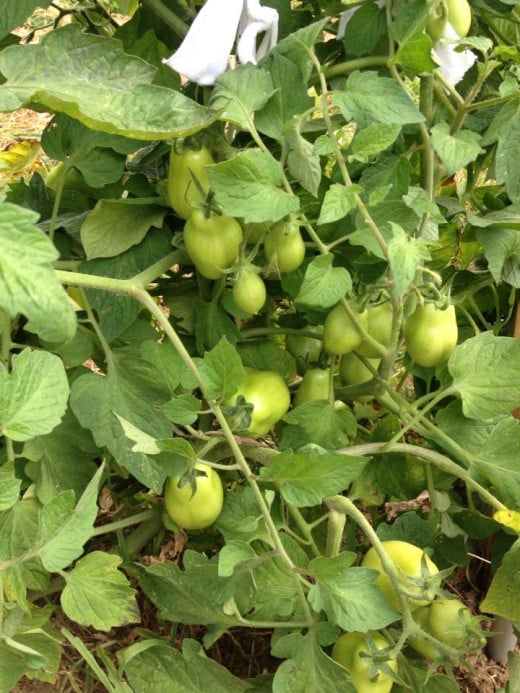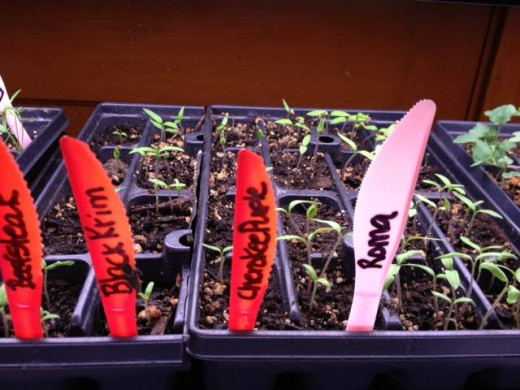How to Grow Organic Tomatoes in Your Garden
Organic Roma Tomatoes in My Garden

Do you grow tomatoes in your garden?
The Tomato
When you look at the typical home gardener's garden bed, you will more than likely see at least a couple of tomato plants. Tomatoes are one of the most popular fruits that people grow every year. The common varieties of the tomato family are very easy to grow so they are a great plant for the beginning gardener.
When most people think about the tomato, they instantly think about the round, red fruit that we purchase in our grocery store. Unfortunately conventional agriculture has led many people to believe that this tomato is the only one available. Nothing could be further from the truth.
The tomato can be grown in a wide variety of colors, textures and flavors so there are other options than the red grocery store fruit. Some of my favorites are:
- The Cherokee Purple Tomato- an old heirloom variety that dates back before 1890. This tomato is a dark purple color.
- Huge Lemon Oxheart- a large, beefsteak yellow tomato. One slice will completely cover the average size hamburger!
- Yellow Brandywine- A beautiful orange tomato that is average size that tastes amazing.
These varieties usually end up in my garden every year right along with the run of the mill red tomato and red cherry tomatoes. So remember that there is a lot to choose from when you plant tomatoes in your garden every year. The types of tomatoes that you want to plant are the first decision that you have to make.
Tomato Seedlings

How to Plant Tomatoes
If you are choosing an heirloom variety tomato, more than likely you will have to start it from seed. This isn't as difficult as it sounds and only takes a few minutes of your time every day. You can refer to my other article titled "How to Start a Garden from Seeds" if you need to know how to do that.
There is only one thing that I do different for tomatoes that I do not do with any other plant. When your tomato plants are small, transplant them into another container periodically and bury an inch of the stem that was originally above the dirt line. This increases the roots in the tomatoes and makes the plants stronger. In my opinion, they also seem to grow large a bit faster.
Planting tomato plants in your garden is fairly easy. You'll want to have a hole ready to go that is surrounded by loose dirt. Take the tomato plant out of the container and place it into the hole. Pull the dirt around the plant base. The tomato is a forgiving plant so the only mistake that you can make is breaking the stem. If you break the stem of a tomato plant, it will die.
Tomatoes in My 2012 Garden

Is it Best to Cage them or Stake Them?
Caging or staking really depends on your personal preference. I do both with my tomato plants depending on how large I allow the plant to get and how heavy the tomato fruits will be. For heavier, beef steak type plants, I usually cage them. Plants that have smaller fruits like cherry tomatoes, usually a stake or two will work just fine.
If the plant is grown in a confined area, I choose to stake it to save room. Just be careful not to put the stake too close to the stem and watch for renegade branches that could benefit from being tied up to keep the fruit off of the ground.
One final note, staking and tying the plant up can make it easier to water than caging. When you water a tomato plant, you want to try to avoid getting any of the foliage wet to prevent the plant from mildewing. If the plant is staked and tied, it creates a greater gap between the bottom branches and the ground for easier watering.
Known Pests and Problems and How to Take Care of Them Organically
We have already touched a bit on mildew problems with the tomato plant and how to keep that from happening. Whenever you water tomatoes, make sure the water stays on the ground around them and not on the plant. Some people find it's easier to water their plants with a watering can than directly from the water hose.
If the leaves on your plants start to have holes and look a bit chewed up, you have just met the famous tomato hornworm. If you look closely at the plant, you'll see this bright green worm guy and he's not real pretty. The best way to get rid of the tomato hornworm is to manually pick them off and dispose of them. Unfortunately this means killing them because if you don't, they will find their way back to your plants.
If you start to see sunken, dark brownish black on the blossom end of your tomatoes, you have just been introduced to blossom-end rot. You'll want to remove those fruits as soon as this problem appears so the plant can put more energy into producing better fruits.
Aphids are another common tomato plant problem. When these guys come to visit, the best way to combat them is by introducing Lady Bugs into the garden. Lady Bugs love to feast on aphids and should take care of the problem quite quickly.
Beautiful Organic Tomatoes from My Garden

Harvesting Your Tomato Crop
Tomatoes are ready to be picked when they are consistent in their particular color and are firm but not still hard. A perfectly ripened tomato that is still on the vine will almost fall off into your hand when you go to pick it. It's important to remember to pick all of your ripe tomatoes because the fruits will fall from the plant onto the ground and start to rot if you don't.
It's OK to pick a tomato before it has fully ripened. Just place the tomato on a counter top or other surface and give it a little time to completely ripen before eating. Sunlight is not necessary for a tomato to ripen off the vine and in fact, it is suggested that you keep your ripening tomatoes out of the sunlight.
A Freshly Picked Organically Grown Brandywine Tomato

How to Store Tomatoes from Your Garden for Future Use
Never store whole tomatoes in the refrigerator. They will lose their texture, flavor and vitamin content in the cooler air. Once the tomato is processed into something like salsa or ketchup, then it is advisable to refrigerate them.
Tomatoes are a high acid fruit so they can easily be processed and canned with the water bath method. Salsa, home made tomato sauce and ketchup can all be water bath canned for later use.
It is possible to store ripened tomatoes for an extended period of time without canning or freezing them. If you have an area that stays at a consistent 55 to 65 degrees, that's where you need to keep them. Do not allow them to be exposed to sunlight.
© 2012 Helena Hasquin









